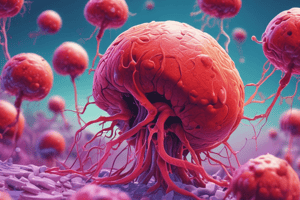Podcast
Questions and Answers
Which of the following cellular adaptations is characterized by an increase in cell size due to increased workload?
Which of the following cellular adaptations is characterized by an increase in cell size due to increased workload?
- Hypertrophy (correct)
- Metaplasia
- Hyperplasia
- Atrophy
In the context of cell injury, what is the primary mechanism by which ischemia leads to ATP depletion?
In the context of cell injury, what is the primary mechanism by which ischemia leads to ATP depletion?
- Increased mitochondrial oxidative phosphorylation
- Reduced oxygen supply to the electron transport chain (correct)
- Increased influx of calcium ions
- Activation of caspases
Which type of necrosis is most commonly associated with tuberculosis infections?
Which type of necrosis is most commonly associated with tuberculosis infections?
- Liquefactive necrosis
- Coagulative necrosis
- Caseous necrosis (correct)
- Fat necrosis
What is the fundamental difference between apoptosis and necrosis regarding inflammation?
What is the fundamental difference between apoptosis and necrosis regarding inflammation?
Which of the following best describes the role of macrophages in chronic inflammation?
Which of the following best describes the role of macrophages in chronic inflammation?
Which of the following is NOT a typical cause of granulomatous inflammation?
Which of the following is NOT a typical cause of granulomatous inflammation?
What is the primary difference between regeneration and scar formation in tissue repair?
What is the primary difference between regeneration and scar formation in tissue repair?
What is the role of formalin in histopathology?
What is the role of formalin in histopathology?
In histopathology, what tissue component is stained blue by Masson's trichrome stain?
In histopathology, what tissue component is stained blue by Masson's trichrome stain?
Which histopathological technique uses antibodies to detect specific proteins in tissue samples?
Which histopathological technique uses antibodies to detect specific proteins in tissue samples?
Flashcards
Pathology
Pathology
The study of disease, including its causes, mechanisms, progression, and effects.
Etiology
Etiology
The cause of a disease; can be genetic, environmental, or multifactorial.
Pathogenesis
Pathogenesis
The sequence of events during disease development; how the cause leads to disease manifestation.
Cellular Adaptations
Cellular Adaptations
Signup and view all the flashcards
Hypertrophy
Hypertrophy
Signup and view all the flashcards
Hyperplasia
Hyperplasia
Signup and view all the flashcards
Atrophy
Atrophy
Signup and view all the flashcards
Metaplasia
Metaplasia
Signup and view all the flashcards
Necrosis
Necrosis
Signup and view all the flashcards
Apoptosis
Apoptosis
Signup and view all the flashcards
Study Notes
No new information found.
Studying That Suits You
Use AI to generate personalized quizzes and flashcards to suit your learning preferences.




